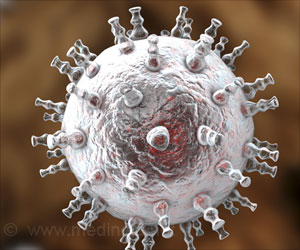Persisting virus in macrophages can cause reactivation of HIV infection even after its eradication from T-cells following anti-retroviral therapy (ART).
- Antiretroviral therapy for HIV infection successfully reduces blood levels of the virus to almost undetectable levels.
- However persistent infection in macrophages leads to rapid reactivation of infection should ART be interrupted.
- Future therapy needs to target HIV reservoirs such as tissue macrophages as well to completely eliminate infection and attain a cure.
Reason for the Study
HIV infection is a major public health concern worldwide. There is no cure or vaccine in sight though various treatments such as antiretroviral therapy (ART) that reduce viral multiplication and transmission are available that allow infected persons to lead productive lives. However, persistence of the virus in reservoirs such as macrophages is a major barrier to achieving eradication of the infection and to prevent its spread to other sites within the body.
However, whether these macrophages responded to ART and whether they represented a potential reservoir of infection even after ART treatment was not still clear. The current study aimed to find out the answer and to carry the research forwards.
Methods and Findings of the Study
Employing a humanized myeloid only mouse model carrying functioning human genes and cells but totally devoid of T-cells, the research team were able to show the following.
- HIV infection in tissue macrophages responded to ART.
- Following suspension of ART, there was rapid reactivation of infection in about 1/3rd of the animals, which corresponded to establishment of persistent infection in tissue macrophages.
Role of Macrophages in HIV Infection
Macrophages are cells of the white cell lineage; in blood they occur as monocytes and in tissues they get modified to form macrophages, an important cell of the immune system. They occur in a wide variety of tissues such as the lung, liver, brain and bone marrow.- Macrophages in the brain and lung can survive for several weeks to years and thus macrophages infected by HIV serve as a major reservoir of infection contributing to reactivation of infection and inability of current therapies to eliminate the virus completely.
- They can disseminate to virtually all organs within the body and contribute to spread of infection within the patient.
- Macrophages have been shown to be critical in mother to child transmission of infection via breastfeeding.
Plans For Future Research
In the future, the research team hopes to elucidate the following:- Factors favoring persistent HIV infection in macrophages.
- Sites in the body where persistently infected macrophages can occur.
- Response of macrophages to possible forms of treatment aimed at eliminating HIV infection from the body.
- Currently, the major limiting factor in HIV treatment is the inability to address viral reservoirs and toxicities plus the cost of treatment that could cause patients to default on treatment.
- Attempts to eradicate viral reservoirs have been bone marrow transplantation and gene therapy in the presence of anti-HIV therapy.
- Initiation of ART early during acute phase of the infection can restrict the formation or the size of the viral reservoir and provide a functional cure.
- Efforts to develop effective vaccines and alternative strategies to achieve HIV cure are being pursued diligently.
- Cellular Reservoirs of HIV-1 and their Role in Viral Persistence - (https://www.ncbi.nlm.nih.gov/pmc/articles/PMC2683678/)
- Current Trends in HIV/AIDS - (http://jscholaronline.org/full-text/JAID/102/Current-trends-in-hiv-aids.php)
Source-Medindia
















